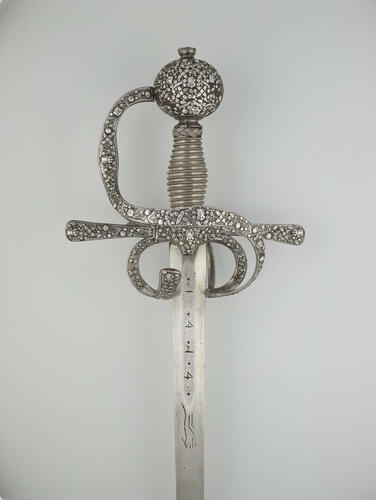Sword 1600-25
Steel, iron, silver, wood | Measurements: length overall 102.3 cm; length of blade 85.9 cm (length) | RCIN 62964
-
The iron hilt consists of a large spherical pommel with a prominent, but badly damaged, tang-button and a broad quillon-block with a rounded point towards the blade supporting a pair of straight quillons of oval section flattened in the plane of the blade; a knuckle-guard; and a pair of fairly large arms, the end of the rear one linked to the centre of the knuckle-guard by a long loop-guard, and the end of the forward arm supporting a straight bar projecting on the outside and slightly curved towards the blade. The end of the knuckle-guard plugs into the pommel. The inner guards consist of a spiral side-ring linking the root of the forward quillon with the end of the rear arm, and a U-shaped bar linking the ends of the arms and slightly curved towards the pommel. Encrusted all over the pommel and the outer side of the guards, except the inner guards, with fine wiry scrolls sprouting small flower heads, some at the centre of saltires of four small leaves, slightly larger, Rosaceae flowers, beech-like leaves and other longer leaves resembling the heads of wheat, all in silver against a blackened ground. On the faces of the pommel these longer leaves form a reticulated pattern. The guards on the inside of the hand and the inner face of the other guards are all now burnished.
The slightly baluster-shaped, wooden grip of oval section is bound with silver wire: a plain, medium wire spirally bound with fine twist, all alternating with five fine wires. Turk’s-head ferrules.
The plain, straight, double-edged blade, which is of flattened-hexagonal section, has a very shallow fuller of medium width. Incised in each fuller are the numbers 'x 1 x 4 x 1 x 4 x', and on the flat on each face, just beyond the end of the fuller, a mark of a stylized running wolf. The tip has been reground.
Hilt, English or possibly French, first quarter of the seventeenth century; blade, German (Solingen) contemporary with the hilt; grip, later
Provenance
Presented before 1804 probably by Maj.-Genl. Sir Francis Thomas Hammond, G.C.H. (died 1840), later appointed Equerry to the Prince in 1811 and in 1814 to Chief Equerry and Clerk Marshal of the Royal Stables. The sword was sent to Windsor from Carlton House on 8 August 1842.
The blade, lacking a ricasso, may not originally have belonged in this hilt. The Carlton House inventory records a fanciful tale that the numbers on the blade refer to the date of the object. 'This sword was brought from Tower, probably one of the swords made for the invasion of France by King Henry V, as it bears date 1414, the year preceeding battle of Agincourt and might have been there'.
However, no satisfactory explanation has been put forward for the cryptic numbers found on some blades. A single unmounted blade inscribed '1414' is still in the Royal Armouries (inv. no. IX.662). Other swords in the Collection (RCIN's 67540 and 72729) have the same numbers, RCIN 62991 is marked '1.4.4.9' and RCIN 61363 is marked '14.41'; further sword blades with 'year' marks survive in the Garter star trophy display of the East wall of the Guard Chamber at Hampton Court Palace. No real explanation for these marks has been put forward other than they may be talismanic.
This type of hilt frequently appears in English portraits of the first quarter of the seventeenth century. There is evidence, however, that hilts of this type were also used in France. Charles I wears swords decorated with silver encrusting in two of his portraits by Mytens, one dated 1628 and the other 1631. The Armory Delivery Book records the issue of this sword to Sir Thomas Lawrence in February 1818 ‘to paint from’, but he does not appear to have used it.
-
Creator(s)
(nationality)(nationality)Acquirer(s)
-
Medium and techniques
Steel, iron, silver, wood
Measurements
Measurements: length overall 102.3 cm; length of blade 85.9 cm (length)
Other number(s)










